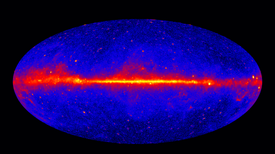Galactic Center GeV excess

The Galactic Center GeV Excess (GCE) is an unexpected surplus of gamma-ray radiation in the center of the Milky Way galaxy that is unexplained by direct observation.[1] As of 2020[update], this excessive (and diffused) gamma-ray radiation is not well understood by astronomers.[2][3][4][5] However, astronomers have suggested that self-annihilating dark matter may be a dominant contributor to the GCE, based on analysis using non-Poissonian template fitting (NPTF) statistical methods,[3] wavelet methods,[5] and studies by other astronomers may support this idea.[6][7] More recently, in August 2020, other astronomers have reported that self-annihilating dark matter may not be the explanation for the GCE after all.[8][9] Other hypotheses include ties to an unseen population of millisecond pulsars[10] or young pulsars, burst events, the stellar population of the galactic bulge,[11] or the Milky Way's central supermassive black hole.[12]
Two percent of the gamma ray radiation in a 30° radius circle around the galactic center is attributed to the GCE. While some controversially argue that it might be radiation from dark matter (which is not otherwise known to radiate) or another exotic explanation, some still believe that conventional objects such as pulsars could explain the GCE.[1]
See also
- Galactic Center – Rotational center of the Milky Way galaxy
- Gamma-ray astronomy – Observational astronomy performed with gamma rays
References
- ^ a b Cho, Adrian (12 November 2019). "Physicists revive hunt for dark matter in the heart of the Milky Way". Science | AAAS. Retrieved 31 March 2020.
- ^ Starr, Michelle (30 April 2019). "Something's Glowing at The Heart of Our Galaxy, But It May Not Be What We Thought". ScienceAlert.com. Retrieved 30 April 2019.
- ^ a b Leane, Rebecca K. & Slatyer, Tracy R. (17 April 2019). "Dark Matter Strikes Back at the Galactic Center". Phys. Rev. Lett. 123 (24): 241101. arXiv:1904.08430. doi:10.1103/PhysRevLett.123.241101. PMID 31922851.
- ^ Fadelli, Ingrid (14 July 2020). "Could recently spotted dim point sources explain the galactic center excess (GCE)?". Phys.org. Retrieved 14 July 2020.
- ^ a b Zhong, Yi-Ming; McDermott, Samuel D.; Cholis, Ilias & Fox, Patrick J. (2020). "Testing the Sensitivity of the Galactic Center Excess to the Point Source Mask". Phys. Rev. Lett. 124 (23): 231103. arXiv:1911.12369. Bibcode:2020PhRvL.124w1103Z. doi:10.1103/PhysRevLett.124.231103. PMID 32603155. S2CID 208512856.
- ^ Cuoco, Alessandro; et al. (4 March 2019). "Scrutinizing the evidence for dark matter in cosmic-ray antiprotons". Physical Review D. 99 (10): 103014. arXiv:1903.01472. Bibcode:2019PhRvD..99j3014C. doi:10.1103/PhysRevD.99.103014. S2CID 119333152.
- ^ Cholis, Ilias; et al. (6 March 2019). "A Robust Excess in the Cosmic-Ray Antiproton Spectrum: Implications for Annihilating Dark Matter". Physical Review D. 99 (10): 103026. arXiv:1903.02549. Bibcode:2019PhRvD..99j3026C. doi:10.1103/PhysRevD.99.103026. S2CID 118857451.
- ^ Starr, Michelle (28 August 2020). "There's a Strange Glow in The Centre of Our Galaxy, And It's Not What We Thought It Was". ScienceAlert.com. Retrieved 28 August 2020.
- ^ Abazajian, Kevork N.; et al. (4 August 2020). "Strong constraints on thermal relic dark matter from Fermi-LAT observations of the Galactic Center". Physical Review D. 102 (43012): 043012. arXiv:2003.10416. Bibcode:2020PhRvD.102d3012A. doi:10.1103/PhysRevD.102.043012. Retrieved 28 August 2020.
- ^ Bartels, Richard; et al. (February 2016). "Strong Support for the Millisecond Pulsar Origin of the Galactic Center GeV Excess". Physical Review Letters. 116 (5). 051102. arXiv:1506.05104. Bibcode:2016PhRvL.116e1102B. doi:10.1103/PhysRevLett.116.051102. PMID 26894696. S2CID 217518922.
- ^ Macias, Oscar; et al. (12 March 2018). "Galactic bulge preferred over dark matter for the Galactic centre gamma-ray excess". Nature Astronomy. 2 (5): 387–392. arXiv:1611.06644. Bibcode:2018NatAs...2..387M. doi:10.1038/s41550-018-0414-3. S2CID 54936254.
- ^ Hooper, Dan & Goodenough, Lisa (21 March 2011). "Dark matter annihilation in the Galactic Center as seen by the Fermi Gamma Ray Space Telescope". Physics Letters B. 697 (5): 412–428. arXiv:1010.2752. Bibcode:2011PhLB..697..412H. doi:10.1016/j.physletb.2011.02.029. S2CID 118446838.
Further reading
- Ackermann, M.; et al. (May 2017). "The Fermi Galactic Center GeV Excess and Implications for Dark Matter". The Astrophysical Journal. 840 (1). 43. arXiv:1704.03910. Bibcode:2017ApJ...840...43A. doi:10.3847/1538-4357/aa6cab. S2CID 119481146.
{{cite journal}}: CS1 maint: unflagged free DOI (link) - Shang, Liangliang; et al. (May 2018). "Interpretations of galactic center gamma-ray excess confronting the PandaX-II constraints on dark matter-neutron spin-dependent scatterings in the NMSSM". European Physical Journal C. 78 (5). 390. arXiv:1804.08797. Bibcode:2018EPJC...78..390S. doi:10.1140/epjc/s10052-018-5827-8. S2CID 55864561.


